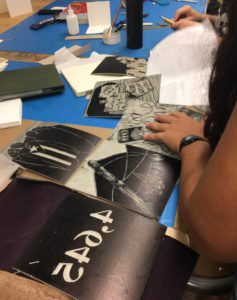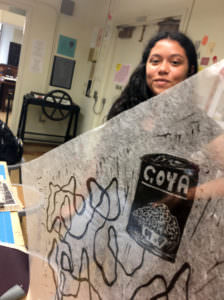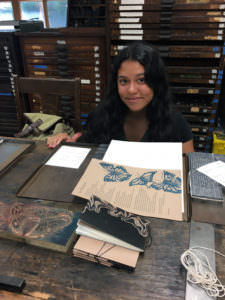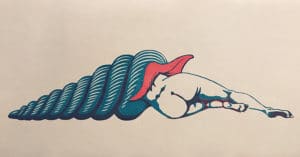
Paper Connection was thrilled to visit Puerto Rican printmaker and book artist Mariana Ramos Ortiz at Brown University’s Walter Feldman Book Arts Studio. Mariana was a visiting scholar at Brown. Her politically engaged work is charged with bold and beautiful block prints.
Collaboration
Mariana collaborated with Brown literary arts lecturer, Erica Mena on a handmade book about colonialism in Puerto Rico titled, Gringo Death Coloring Book, inspired by the content and subtitle of Under the Bed is Another Country, by Raquel Salas Rivera. Mariana created the book’s stunning block-printed illustrations on Tengujoushi. This delicate paper gave the images a translucent presence from which to see through to their hand-made abaca paper.

Q+A
PCI: Mariana, thank you for taking time to share insights into your process and current projects in the studio. We are excited to learn more about you and your work! How did your research in visual arts bring you to Brown University from Puerto Rico?
MR: Thank you for your interest in my work. My relationship to Brown University started when I became a visiting student during the Fall 2018 semester. Brown reached out to the University of Puerto Rico (UPR) to harbor 30 students during the difficult situations Puerto Rico was (and still is) going through as a result of the passing of Hurricane María through the island. I was lucky to form part of the group of students that later on stayed for the entire academic year. During the Fall semester I took a Book Arts course with Prof. Erica Mena. This course was the highlight of my whole stay at Brown. Prof. Erica and I, bonded over our creative interests and that resulted in a partnership this summer, creating the Gringo Death Coloring Book.
PCI: Can you describe the importance of paper in your work and what types of paper you use most?
MR: My relationship with paper has grown quite a lot this year, especially with my involvement in the book arts community and the many visits I made to your lovely shop. Paper has always played an important role in my work, specially because I enjoy experimenting with chine collé and other printmaking techniques. I have to admit that I have a very unhealthy obsession to brown/espresso colored papers. I have always been drawn to them because at the UPR’s printmaking studio, where I usually work, we do not have a budget for buying “high-quality printmaking papers”, therefore we use a lot of brown kraft paper. I guess the constant use made me develop an appreciation for brown papers. This is also the reason why when Erica and I saw the amate paper, we knew we had to incorporate it into our book.
PCI: When we visited you at the Brown Book Arts Studio, you mentioned something interesting about your relationship to paper. More specifically, when you began working at Brown doing printmaking, you were astonished to see that test printing was done on a high-quality printmaking paper. Your reaction addresses a difference towards resources. Can you elaborate on this personal perspective and how others might reflect on this within academia and beyond?
MR: During my first crit in the printmaking course I was taking last semester, I remember that we had a big stash of BFK papers and I chose to show my piece printed in kraft brown paper. As I said in my previous answer, BFK, Strathmore and Arches are considered luxuries for many printmakers in Puerto Rico and I was always taught that those papers were for final prints or prints that would be shown to the public. This said, using high-quality paper for test prints made me feel like I was going against a printmaking principle. That experience really did open my eyes to the amount of resources some institutions have and how sometimes we can become careless of those resources that are not easily accessible to other communities. Although having unlimited resources does foster infinite creative freedom, I think it is still important to be conscious of when we are unnecessarily wasting materials.
PCI: In working on Gringo Death Coloring Book, you used Paper Connection’s tengujoushi for your block printing. Can you describe the printing process for this thin, translucent kozo paper?
MR: Working with tengujoushi was very exciting! It has been one of the most challenging papers I have ever printed on. I really liked the movement and translucent effect it produced so I was very determined to make this paper work. The key element when printing with tengujoushi is regulating the amount of ink on your blocks, because it is very easy for the paper to get ripped off by the motion of the letter press if you have an over inked block. It took me some time to understand how far the material could go and I think I was able to make it work in my favor. The tengujoushi was amazing for gluing the tabs on our book, since it is so transparent that you do not have to be extremely precise with your gluing.
PCI: Is there a particular question that no one has asked you that you wish they had with regards to your creative practice, philosophy or recent experiences in the US?

MR: I guess one question I would like to answer is: What would I like to work on if I ever return to Rhode Island? My answer to that question would be: During my time at Brown I was able to work on amazing projects within the academic community. However, If I ever return (which I really hope so) I would like to get more involved with the Rhode Island community and become a bridge between what goes on at College Hill and what goes on outside of College Hill.
Mariana and Erica’s book, Gringo Death Coloring Book
will be available soon, so follow their updates on social media.
Congratulations to Mariana on her recent interview with Forbes magazine – Bravo!


1 comment
Namir
Felicidades Mariana ! For your talent, determination and excelent work.
Brown Unoversity , Erika Mena and all the people to support Puertorrican students and frt gave the opportunity to express theirs talent.